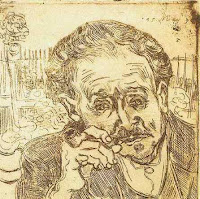
The museum's founder, Andrew Carnegie, was a man of paradoxes, like Hopper was a man of silences. Carnegie lived like a king yet hated the ruling class; made millions but gave it all way. He built a library for any town in the U.S. that subsidized 10% of the costs. And he founded many philanthropic entities, including this university and its museum. He envisioned it as collecting the "Old Masters of tomorrow" (a great way to describe Hopper).
The Carnegie was home to Van Gogh's only etching. The etching shows Paul Ferdinand Gacher, a doctor who also was an etcher and probably taught Van Gogh the technique. Similarly, Hopper also had his earliest success with etching and learned from his friend Guy Pene Du Bois. Hopper was also famous for his renditions of buildings, and The Carnegie had a Hall of Architecture inspired by the Mausoleum at Halicarnassus and the largest collection in the U.S. of plaster cast architecture, a common practice in the late 1800s.
Hopper's idol Thomas Eakins was represented by a portrait of Joseph R. Woodwell,  who was in turn represented by a painting titled Pennsylvania House.
who was in turn represented by a painting titled Pennsylvania House.  Beside Henry Ossawa Tanner's painting Christ at the Home of Mary and Martha was a sign explaining that Tanner was born in Pittsburgh's Hill District and eventually studied with Eakins.
Beside Henry Ossawa Tanner's painting Christ at the Home of Mary and Martha was a sign explaining that Tanner was born in Pittsburgh's Hill District and eventually studied with Eakins. 
At the museum store, I found Cape Cod Afternoon on the side of a kaleidoscope for sale. It made me think how using him as a lens had led me to see ever-shifting patterns across the U.S. I interviewed the worker behind the store counter: a woman with sallow skin, freckles, a sharp nose, and a set jaw. She had gray hair and wore a pink shirt and a long, thick gold rope that followed the upper hem of her denim jumper. 
"I don't think of the people in Pittsburgh as isolated. Every now and then, we get homeless people here or in the library next door, and of course, I don't commune with those people. But there are times when very lonely people have hung out here. Sad to say that certainly everywhere there are people that fit into that category." She suddenly asked, "What years did Hopper live?"
"1882-1967."
"That means that his last few years he was quite up in years."
"But he was still painting."
"He still painted," she sighed. "He was physically still active. Oh that was fortunate. And his wife outlived him. That was lucky for him, that there was someone there for him."
20090226
166 Pittsburgh, PA: Lucky
Subscribe to:
Post Comments (Atom)




No comments:
Post a Comment